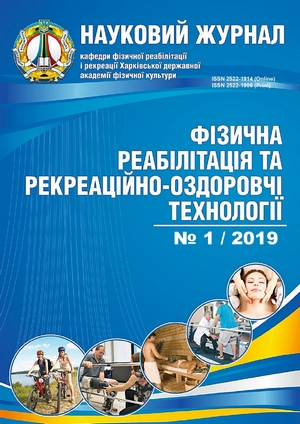Basics of determining the optimal load in the process of physical rehabilitation of schoolchildren with antisocial behavior
DOI:
https://doi.org/10.15391/prrht.2019-4(1).02Keywords:
ндивідуальне дозування, асоціальна поведінка, рухова активність, реабілітація, фізична культураAbstract
Purpose: to investigate the age-related patterns of adaptation of the body of schoolchildren of various types of behavior to physical exertion, to experimentally substantiate the optimal technology of their individual dosage. Material and methods: in order to identify the age-related patterns of adaptation of the body of schoolchildren of various types of behavior to physical exertion, 215 students aged from 11 to 17 years of schools No. 1, 15, 20 of Slovyansk, Donetsk region were tested. Testing was carried out at the beginning and at the end of the study. The students formed a control group and an experimental group. Results: according to our data, schoolchildren normally have an advantage in the realization of motor potential, while students of the "risk group" are noticeably inferior to their peers in this component of motor action. Conclusions: It is experimentally proven that the normalization of physical load is more promising by the value of INPB than based on the results of heart rate measurement during work.
References
Белогуров С.Б. Научно о наркотиках и наркоманах.- М.: СПб.: Невський диалект-Бином, 1998.- 128с.
Важковиховуваність: сутність, причини, реабілітація (Ред.). (2009).Суми.Університетська книга.
Воронцова М. В. (Ред). (2014).Теория деструктивности. Таганрог. Издатель А.Н. Ступин.
Воспитание трудного ребенка. Дети с девиантным поведением(Ред.).(2001).Москва. Гуманит. изд. центр ВЛАДОС.
Вольнова Л. М. (2016). Профілактика девіантної поведінки підлітків: навч.-метод. посібник до спецкурсу «Психологія девіацій» для студентів спеціальності «Соціальна робота» у двох частинах. – Ч. 1. Теоретична частина. – 2-ге вид., перероб і доповн. Київ.
Курек Н.С. (1993) Медико-психологический подход к диагностике повышенного риска заболевания наркоманией у подростков. Вопросы наркологии. № 1. С.54-59.
Ковальчук М. А. (Ред). (2013).Девиантное поведение: профилактика, коррекция, реабилитация. Гуманитар. изд. центр ВЛАДОС.
Котляров А. В. (Ред). (2006). Другие наркотики или Homo Addictus. Москва. «Психотерапия».
Моченова В.П. (1999). Спорт против наркотиков. Физкультура. № 3-4. С.61-63.
Петракова Т.И. (1991). Руководство по профилактике наркомании среди детей и подростков. Москва. Медицина.
Самойлов А. М. (2016) Типи девіантних підлітків. Матеріали V Міжнародної інтернет-конференції молодих учених і студентів. Глухів. РВВ Глухівського НПУ ім. О.Довженка.
Самойлов А. М. (2014). Педагогічний потенціал соціально-культурного середовища школи в системі профілактики девіантної поведінки підлітків. Матеріали ІІ Всеукраїнської конференції молодих учених і студентів. Вінницький державний педагогічний університет імені Михайла Коцюбинського. ТОВ фірма «Планер».
Downloads
Published
Versions
- 2023-10-22 (2)
- 2023-10-22 (1)
Issue
Section
License
Copyright (c) 2021 А.О. Щелкунов, С.С. Лисенко, В.А. Шульга

This work is licensed under a Creative Commons Attribution 4.0 International License.

